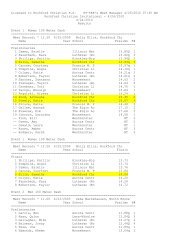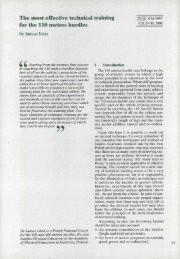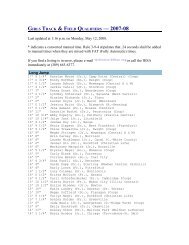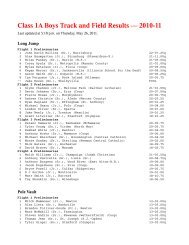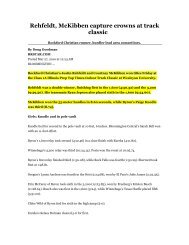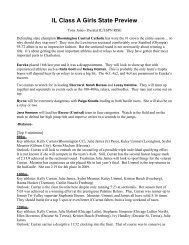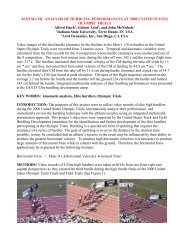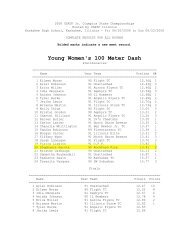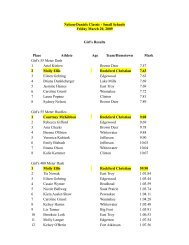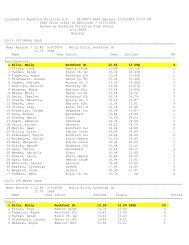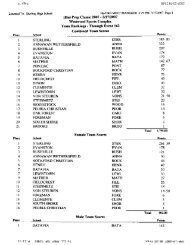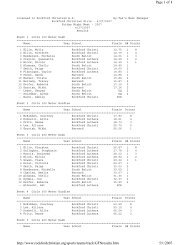Training Considerations for the Long Hurdles - HurdleCentral.com
Training Considerations for the Long Hurdles - HurdleCentral.com
Training Considerations for the Long Hurdles - HurdleCentral.com
You also want an ePaper? Increase the reach of your titles
YUMPU automatically turns print PDFs into web optimized ePapers that Google loves.
<strong>Training</strong> <strong>Considerations</strong> <strong>for</strong> <strong>the</strong> <strong>Long</strong> <strong>Hurdles</strong><br />
Nathan Wiens – Iowa State University – Sprints/<strong>Hurdles</strong><br />
We will cover five basic objectives in <strong>the</strong> long hurdle race. 1) Identifying a Potential <strong>Long</strong> Hurdler, 2)<br />
Developing a Balanced Approach to <strong>Training</strong> <strong>the</strong> Biomotor Abilities 3) Development of Power and Speed, 4)<br />
Development of Aerobic Ability and Anaerobic Tolerance, 5) Identifying Per<strong>for</strong>mance <strong>Considerations</strong> and 5)<br />
Creating a <strong>Training</strong> Design. These five topics should move a coach from <strong>the</strong> beginning stages of identifying<br />
potential long hurdler through designing a training program to meet <strong>the</strong>ir needs.<br />
Objective #1: Identifying a Potential <strong>Long</strong> Hurdler<br />
Primary concern <strong>for</strong> high school athletes is identification of an athlete with <strong>the</strong> biomotor abilities to sprint <strong>the</strong><br />
400m effectively (or willingness to train to do so) with <strong>the</strong> mental toughness to engage 10 barriers along <strong>the</strong><br />
way.<br />
The 400m hurdles are one of <strong>the</strong> most exclusive events when identifying potential athletes. Athletes must<br />
possess, 1) The desire and heart to train like a 400-600m runner, 2) Strength; A balanced high level of core<br />
strength, maximal strength and strength endurance, 3) The mental focus, concentration and attitude to be<br />
aggressive on negotiating 10 barriers over 400m, 4) The flexibility and coordination of a short hurdler, 5) <strong>the</strong><br />
steering ability of a pole vaulter/horizontal jumper, 5) And last but not least, sprinting ability as speed is <strong>the</strong><br />
primary limiting characteristic throughout all <strong>the</strong> sprint events.<br />
Objective #2: Develop a Balanced Approach to <strong>Training</strong> <strong>the</strong> Biomotor Abilities<br />
There are five primary biomotor abilities. Speed, Strength, Endurance, Coordination and Flexibility. A<br />
balanced approach to training <strong>the</strong>se attributes is needed because <strong>the</strong>y are interdependent on one ano<strong>the</strong>r. Great<br />
improvement of one ability is impossible without parallel improvement of <strong>the</strong> o<strong>the</strong>rs. Every microcycle or week<br />
long plan should include training that incorporates all five abilities. Each week should have an individual focus<br />
(speed, strength, endurance etc.) but not lack attention to <strong>the</strong> o<strong>the</strong>rs.<br />
Objective #3: Development of Power and Speed<br />
Although all biomotor abilities must be trained in connection with each o<strong>the</strong>r, speed must be addressed at <strong>the</strong><br />
beginning stages of training. Done well, proper training of <strong>the</strong> speed <strong>com</strong>ponent will ensure that correct sprint<br />
mechanics will be established and carried throughout <strong>the</strong> year. A technically efficient hurdler will make larger<br />
gains in improving stride length and stride frequency (<strong>the</strong> two factors that determine <strong>the</strong> speed of an athlete)<br />
throughout <strong>the</strong> course of training and will have a higher adaptation rate to <strong>the</strong> o<strong>the</strong>r biomotor abilities.<br />
However, if proper technique is not en<strong>for</strong>ced early on, <strong>the</strong>n training sessions can result in improper muscle<br />
memory and damage to soft tissue as <strong>the</strong> season progresses.<br />
Phases of training power and speed are designed to progressively increase:<br />
Speed => Short Speed Endurance => Speed Endurance => Special Endurance 1 => Special Endurance 2 (See<br />
Chart).<br />
Exercises utilized in speed and power sessions include acceleration runs, fly’s, sprint/flow/sprint or alternating<br />
speed runs at maximal levels, resisted and assisted runs, multi-jumps, multi-throws, Olympic lifts, and<br />
functional core development work.<br />
Objective #4: Development of Aerobic Ability and Anaerobic Tolerance<br />
This objective is to increase energy system functioning. Energy systems are responsible <strong>for</strong> providing an energy<br />
rich <strong>com</strong>pound called ATP to fuel muscle work and recovery. The first energy system is <strong>the</strong> anaerobic (ATP-<br />
PC) Energy System which gives us 5-8 seconds of ATP Production. The second is <strong>the</strong> Anaerobic Lactate<br />
(Glycolytic) System where <strong>the</strong> breakdown of glucose or glycogen in anaerobic conditions results in <strong>the</strong><br />
production of lactate and hydrogen ions. The accumulation of hydrogen ions is <strong>the</strong> limiting factor in runs of<br />
300-800m at above 85-90% ef<strong>for</strong>t. The Aerobic Energy System utilizes proteins, fats and carbohydrates<br />
(glycogen) <strong>for</strong> resyn<strong>the</strong>sizing ATP.
In increasing energy system functioning, we hope to increase <strong>the</strong> athlete’s lactate threshold to minimize <strong>the</strong><br />
effects of hydrogen ion interference with motor unit operation. To help <strong>the</strong> long hurdler achieve higher energy<br />
system functioning, extensive and intensive tempo runs are used. Distances of 100-600 meters are used and<br />
times are calculated off a percentage of 200m and 400m personal bests or goal paces.<br />
As speed is a precursor to speed endurance, extensive tempo runs are a precursor to intensive tempo. Extensive<br />
tempo runs greatly assist <strong>the</strong> athlete in <strong>the</strong>ir ability to handle greater work loads and volumes and prepares <strong>the</strong><br />
athlete <strong>for</strong> quicker recovery between sets/reps <strong>for</strong> workouts later in <strong>the</strong> year. Intensive tempo work is more<br />
intense and mixes <strong>the</strong> aerobic and anaerobic energy systems and begins to prepare <strong>the</strong> body to undergo training<br />
associated with lactate buffering.<br />
Lastly, as speed moves towards speed endurance and intensive tempo moves <strong>the</strong> athlete towards <strong>the</strong> ability to<br />
handle special endurance workouts, we find ourselves nearing or in <strong>the</strong> midst of <strong>the</strong> early <strong>com</strong>petition season.<br />
Special Endurance 2 runs are a means of increasing <strong>the</strong> body’s tolerance of hydrogen ions or creating a lactate<br />
buffer. When per<strong>for</strong>ming special endurance 2 workouts, athletes will be flooded with lactate. Since hydrogen<br />
ion accumulation slows <strong>the</strong> contractile activity and <strong>the</strong> rate of glycolysis within <strong>the</strong> muscle and limits <strong>for</strong>ce<br />
production, <strong>the</strong>se runs are prescribed during <strong>the</strong> pre-<strong>com</strong>petition to <strong>com</strong>petition phases to aid in lactate<br />
tolerance.<br />
The physical and mental toll of <strong>the</strong>se workouts can be very demanding. Focus through <strong>the</strong>se microcycles<br />
should be given to <strong>the</strong>se workouts and subsequent recovery periods and modalities need to also ac<strong>com</strong>pany<br />
<strong>the</strong>se days.<br />
Objective #5: Identifying Per<strong>for</strong>mance <strong>Considerations</strong><br />
This objective concerns <strong>the</strong> integration of hurdle technique and specific training into <strong>the</strong> mainframe of <strong>the</strong><br />
training design. The below considerations are listed in order of importance and need to be integrated into <strong>the</strong><br />
training design. Progression through <strong>the</strong> third and into <strong>the</strong> fourth point should occur be<strong>for</strong>e <strong>the</strong> first outdoor<br />
race.<br />
1) Ability to apply <strong>for</strong>ce at takeoff to move through <strong>the</strong> hurdle and minimize deceleration.<br />
2) Ability to per<strong>for</strong>m effective and efficient hurdling skills with both legs.<br />
3) Ability to maintain a consistent rhythm <strong>for</strong> 8-10 hurdles.<br />
4) Ability to manage race distribution efficiently.<br />
Stages in Technical Learning<br />
1) Develop General Fitness<br />
a. Permits <strong>the</strong> athlete to learn and repeat correct movements without having to <strong>com</strong>promise <strong>for</strong><br />
weaknesses.<br />
2) Develop Basic Technique<br />
a. Basic technique must be learned correctly so that it can be built upon at faster speeds. The<br />
earlier <strong>the</strong> athlete learns <strong>the</strong> earlier he/she will ensure correct muscle memory. (Look <strong>for</strong> 85-<br />
90% mastery of <strong>the</strong> technique.)<br />
3) Develop Specific Fitness<br />
a. Raises <strong>the</strong> potential <strong>for</strong> more total expression through technique<br />
4) Develop Advanced Technique<br />
a. Advanced technique implies <strong>the</strong> optimal speed, strength, endurance, etc. can be expressed at<br />
<strong>the</strong> highest level of per<strong>for</strong>mance.
Objective #6: Creating a <strong>Training</strong> Design<br />
When developing a training design <strong>for</strong> <strong>the</strong> long hurdler, coaches should start with <strong>the</strong>ir athlete’s final week of<br />
<strong>com</strong>petition in mind and move backward throughout <strong>the</strong> season. This way, <strong>the</strong> athlete will peak at <strong>the</strong> correct<br />
time without disturbances in training due to trying to <strong>for</strong>ce-in or string-out objectives throughout <strong>the</strong> phases.<br />
<strong>Training</strong> <strong>for</strong> <strong>Long</strong> Hurdlers – Weekly <strong>Training</strong> Cycles<br />
Fall <strong>Training</strong> – General Prep<br />
Monday: Sprint Development/Acceleration/Hurdle Skill/Plyo’s/Weights<br />
Tuesday: Tempo Running/Weights<br />
Wednesday: Recovery/Core <strong>Training</strong>/Circuit <strong>Training</strong>/Swimming/Flexibility<br />
Thursday: Technical Runs/Transition Drills/Weights<br />
Friday: Hill Running/Strength Endurance/General Strength<br />
Saturday: Aerobic Development/Extended Warm-up/Fartlek Runs/Core <strong>Training</strong>/Flexibility<br />
Sunday: Rest<br />
Specific Prep/Pre-Competition Phase<br />
Monday: Sprint Development/Power Development/Hurdle Skill/Plyo’s/Weights<br />
Tuesday: Hill Running or Extensive-Intensive Tempo/Strength Endurance/Weights<br />
Wednesday: Recovery/Core <strong>Training</strong>/Circuit <strong>Training</strong>/Swimming/Flexibility<br />
Thursday: Hurdle Skill/Technical Runs/Weights<br />
Friday: Specific Endurance/Lactacid Capacity/General Strength/Flexibility<br />
Saturday: Extended Warm-up/Tempo/Core <strong>Training</strong><br />
Sunday: Rest<br />
Indoor-Competition Phase<br />
Monday: Speed-Power Development/Plyo’s/Weights<br />
Tuesday: Hurdle Skill/Weights/Multi-jumps<br />
Wednesday: Lactacid Power/Strength Endurance<br />
Thursday: Recovery/Swimming/Weights/Core <strong>Training</strong><br />
Friday: Pre-meet Routine/Acceleration<br />
Saturday: Competition<br />
Sunday: Rest<br />
Competition Phase<br />
Monday: Hurdle Skill/Plyo’s/Weights<br />
Tuesday: Lactacid Power/400m Hurdle Distribution/Weights/Core <strong>Training</strong><br />
Wednesday: Recovery/Core <strong>Training</strong>/Swimming or Tempo Running<br />
Thursday: 400m Hurdle Starts/Weights<br />
Friday: Pre-meet Rountine/Easy Acceleration<br />
Saturday: Competition<br />
Sunday: Rest<br />
Monday<br />
Tuesday<br />
Fall Specific/Pre-Comp Indoor-Comp Outdoor Comp<br />
Acceleration Complexes,<br />
Resisted Runs, Multi-Jumps,<br />
Multi-Throws, Plyo’s<br />
Circuits w/100-200m runs<br />
2-3X8X100m<br />
12-20X200m<br />
2-3X3X300m<br />
3X4X30 Rest: 3’/7’<br />
3X3X40 Rest: 3’/7’<br />
2X5X50m Rest: 3’/7’<br />
2X250, 200, 150m Hills<br />
6X60sec hills<br />
8-12X200m<br />
Stabilization of sprinting<br />
ability & power<br />
development.<br />
Hurdle skill and<br />
refinement of hurdle<br />
ability with both legs<br />
Wednesday Recovery/Core <strong>Training</strong> Recovery/Core <strong>Training</strong> 2X500, 3X200<br />
2X450, 3X200<br />
3-4X350<br />
Thursday<br />
Friday<br />
Saturday<br />
Marching & Skipping Over<br />
<strong>Hurdles</strong> - Sprint Drills,<br />
Technical Runs, Hip<br />
Placement, Foot Strike, Shin<br />
Angles<br />
10X100 Hills<br />
8-10X150m Hills<br />
6-8X200m Hills<br />
Extended Warm-up<br />
Fartlek/1’on 2’ off <strong>for</strong> 30’<br />
Cross Country Runs<br />
Hurdle Skill -<br />
Maximize effective<br />
hurdling with both legs<br />
2X2X500m<br />
600,400,200,400,600<br />
2X600, 3X300<br />
Extended warm-up<br />
<strong>com</strong>plex/sprint drills<br />
& jogs + tempo strides<br />
Recovery, Swimming to<br />
maintain endurance and<br />
strength levels, Core<br />
Work and Weights<br />
Pre-Meet<br />
Acceleration<br />
Hurdle Starts<br />
Competition<br />
Sunday Rest Rest Rest Rest<br />
Hurdle skill and speed<br />
drills over hurdles.<br />
Hurdle Distribution<br />
450, 400, 350, 300<br />
350, 200, 100, 300<br />
2X320<br />
Recovery/Core/Swimming<br />
or Tempo Running<br />
Hurdle Skill -<br />
Starts to <strong>the</strong> first<br />
hurdles/Rhythm<br />
Pre-Meet<br />
Acceleration/Handoffs<br />
Rest/Recovery<br />
Competition
Categorization of Methods and Means<br />
Volume Range Per Session<br />
(Examples of how energy system <strong>com</strong>ponents can be<br />
categorized <strong>for</strong> planning) Based on Best Race Distance<br />
Common<br />
Terminology<br />
Length Of Component and Description Energy<br />
Run of Objective System<br />
Percen<br />
t of<br />
Best<br />
Mark<br />
Rest Interval<br />
Between<br />
Reps/Sets<br />
100m<br />
200/100<br />
mH<br />
400/400<br />
mh<br />
minmax<br />
minmax<br />
minmax<br />
Extensive tempo >200 Aerobic capacity (AC) Aerobic



